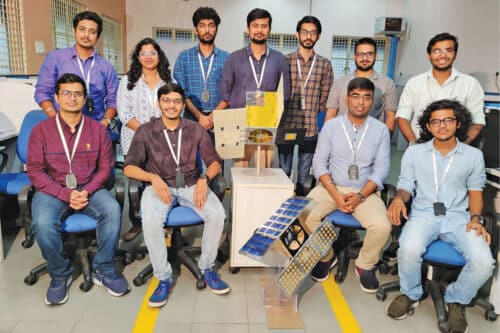GalaxEye, an IIT Madras incubated space tech startup, aims to send a constellation of satellites equipped with their proprietary sensor, called Drishti, into space
The founders of GalaxEye have developed and launched the Drishti sensor, a patent-pending technology that is also their USP. “The Drishti sensor enables multi-sensor fusion,” says Suyash Singh, Co-Founder and CEO, GalaxEye. In simple words, Drishti sensors are basically a hybrid version of multiple sensors—hence, multi-sensor fusion. There are multiple sensors today that are used on an individual basis, like thermal sensors, radiometers, or radars on a satellite. But GalaxEye’s Drishti sensors are able to give comprehensive data that anyone would want from a satellite since they are a combination of many sensors.

44wThe Drishti sensors themselves are not commercially available. They will be deployed on GalaxEye’s satellites only. What the company will be making commercially available is the dataset obtained from the sensors. GalaxEye believes that this dataset will be able to serve any sector that requires satellite imagery—insurance, agriculture, utilities, defense, etc.
GalaxEye’s mission is to launch a constellation of satellites working in tandem to provide imagery. “We will have a group of such satellites monitoring the Earth on daily basis,” explains Singh. This constellation will provide insights both during day/night time and irrespective of weather conditions. However, their short-term goal is to launch their first satellite in some time, probably by the end of 2023.
It is well said that big success does not come without challenges—at times, the volume of the data that needs to be transferred from one point to another is challenging. GalaxEye is solving that challenge by building a dashboard with a map for users to draw a cross-sectional area on. The company will then deliver the data for that particular area.
Dealing with market competition is critical for all companies. Even in the space technology business, there are some global players who are doing satellite imagery using single sensor based imaging. What differentiates GalaxEye from them is the multi-sensor fusion mentioned earlier. It is this differentiation that they bring to the table that’s very important for the customers.
GalaxEye, like most startups these days, has a very unique story of how it was launched. In 2020, the company was founded by a team of five students/alumni of IIT Madras, who initially were a part of Team Avishkar Hyperloop—a student competition team. In 2019, the team participated in the SpaceX Hyperloop Competition and that’s how GalaxEye came into being. “A few of us from the Hyperloop team were really excited about space technologies in general,” recalls Singh.
Singh points out that the Indian government, ISRO, and some universities have been taking steps towards getting students interested in space technology—like launching student space programmes and interdisciplinary courses. He throws light on how students can get started in a niche field like space technology, “Students can start with drones and communication, and then, if interested, they can move forward to taking specialised subjects during the PG.”






